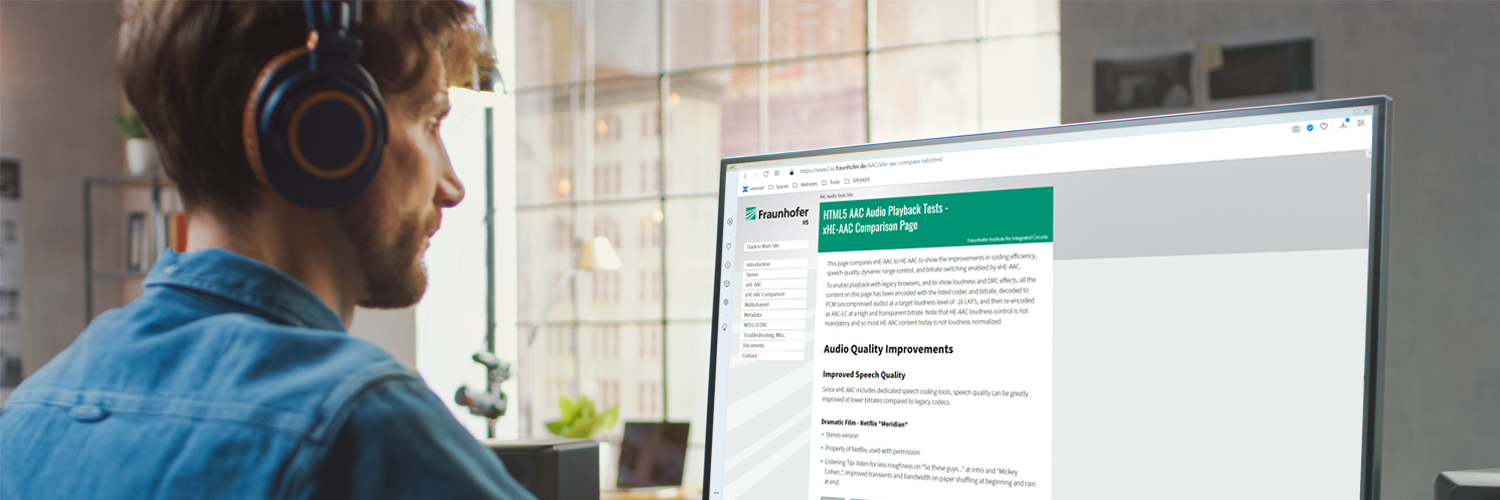Fraunhofer has added a new page to its website to illustrate the dramatic improvements and distinct benefits that xHE-AAC offers to consumers and service providers alike over previous AAC generations such as HE-AAC. The fourth generation of the AAC codec family, xHE-AAC, improves audio quality at lower bit rates, allows seamless streaming over a 12 to 500 kbit/s bit rate range, and includes mandatory loudness and dynamic range control technology.
The page allows a visitor to hear audio samples of film and music content encoded and decoded at several bit rates with both xHE-AAC and the legacy HE-AAC codec.
On film content, such as Netflix’s Meridian item, the roughness of speech reproduced by the HE-AAC codec at low bit rates is substantially reduced by xHE-AAC. xHE-AAC includes a separate speech codec that is automatically used when it provides a better encoding quality, allowing the audible coding artifacts on speech to be greatly reduced. On this item, one can also hear the increased audio bandwidth provided by xHE-AAC, heard for example on papers shuffling at the beginning or the rain at the end of the item.
On music, xHE-AAC also offers substantial improvements. On the Farewell item on the site, warbling artifacts, typical when HE-AAC is unable to properly allocate bits, are heard on the piano. On the Walking item, stereo image improvements are shown. The Rain item includes both warbling on the guitar and a less precise stereo image with HE-AAC. This latter item also illustrates codec-induced reverberation on the guitar notes with HE-AAC.
These improvements will allow content distributors to use lower bit rates with xHE-AAC than was possible with HE-AAC, while still maintaining acceptable audio quality.
Equally important is xHE-AAC’s mandatory loudness and dynamic range control capability. The loudness control feature allows content to be normalized to a desired average loudness level, avoiding irritating listeners with frequent volume control adjustments. The dynamic range control feature allows tailoring the content’s dynamic range so it can be enjoyed in difficult listening environments with high background noise. The site allows playback of two film items with and without dynamic range control applied. Visitors can switch on masking noise to hear the effectiveness of xHE-AAC’s dynamic range control on intelligibility of dialogue when they are listening in noisy situations such as on an airplane, outdoors, or in a crowded place.
Finally, the site includes a demonstration of the seamless audio bit rate switching provided by xHE-AAC, switching bit rates every two seconds over a 24 to 128 kbit/s range with no audible artifacts. This switching capability allows listeners to hear high quality audio when they are streaming over a good network connection, yet avoid dropouts if network conditions worsen.
The HE-AAC audio samples on the site were produced with Fraunhofer’s standard HE-AAC encoder implementation operating at its best for the bit rates selected – they were not “made worse” in any way.
About xHE-AAC
xHE-AAC is the latest member of the MPEG AAC audio codec family. Fraunhofer played a substantial role in the development of xHE-AAC and the MPEG-D DRC standard. xHE-AAC is natively supported in the latest Apple, Android and Amazon operating systems and products, and Fraunhofer’s xHE-AAC implementation has recently been licensed to Microsoft. Professional xHE-AAC encoder software is available directly from Fraunhofer IIS or its streaming equipment partners. xHE-AAC and MPEG-D DRC patents are included in the AAC patent licensing program administered by VIA Licensing at no additional cost.
Header image: © Gorodenkoff – stock.adobe.com / Fraunhofer IIS

